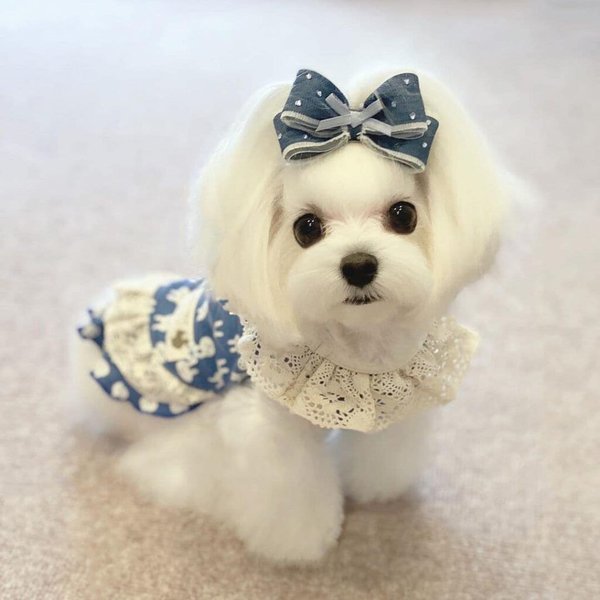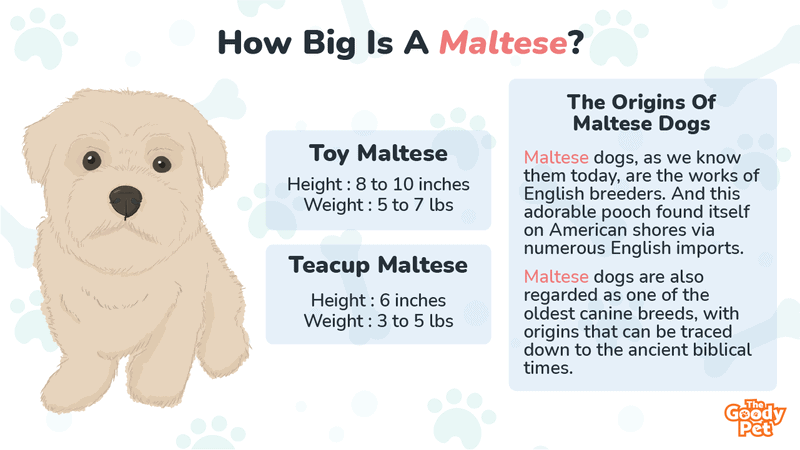Cute and sprightly, the Maltese is a pooch that never fails to capture the heart of all it comes across, and this article aims to examine the differences between the size variants of this fido.
Now, how big does a Maltese grow? The Maltese is a small sized dog that typically weighs less than seven pounds when fully grown. Maltese dogs also stand between seven to ten inches at maximum height, and certain size variants of this pooch can comfortably fit into a teacup!
Since the Maltese is a small dog breed, special attention must be paid to this pooch’s nutrition, and dietary requirements for all size variants of the Maltese are outlined in this article. Information on the Maltese’s temperament, and whether this pooch will make the ideal pet for your home is also discussed briefly. But before we get started, let’s see what sizes Maltese dogs are typically available in.
Are There Different Sizes Of Maltese Dogs?
Generally, Maltese dogs are classified into two based on the pooch’s body size – we have the Toy Maltese and the Teacup Maltese dogs.
Some breeders also acknowledge the existence of the Miniature Maltese dog, but this classification isn’t nearly as popular as the Toy and Teacup Maltese groupings.
Maltese dogs, by default, are classified as a toy dog breed, and it is only when this pooch is smaller than normal that it is considered to be a teacup. And apart from the differences in height and weight, both Toy and Teacup Maltese dogs are practically the same in other aspects, including physical appearance, personality, and grooming requirements.
How Does A Maltese Dog Look?
Perhaps the most distinguishing feature of a Maltese dog, be it teacup or toy, is the pooch’s thick, single-layered coat that comes in a snowy white coat!
And in addition to the coat, the typical Maltese dog can be easily identified by its small, rounded head and body, with ears that are mostly dropped downwards. The Maltese dog also has eyes and a nose that are dark in color and a sharp contrast to the pooch’s white coat.
Is The Maltese A Good Family Dog?
Both Toy and Teacup Maltese dogs are renowned for being gentle, playful, and affectionate towards just about anybody they come across.
The Maltese does well in a family setting, and thanks to this pooch’s small size, it can adapt well to living in either a small house or a large apartment with lots of space.
Additionally, owning to their temperaments, Maltese dogs are extremely good and gentle with children. With proper socialization, they get along well with other dogs and domestic pets. However, due to the Maltese’s frail nature, this pooch is best suited for homes with older, mature children that know how to handle small dogs like the Maltese.

How Big Does A Toy Maltese Get?
As stated earlier, Maltese dogs are classified as a toy breed by default. And both male and female pooches of this dog breed typically weigh between 5 and 7 lbs when fully grown.
If you’re to register your Maltese with the American Kennel Club, it is important that this pooch weighs no more than 7 lbs, as any weight above that does not fall under the breed standard for a Maltese.
When it comes to height, there are slight differences between both male and female Maltese dogs. And these differences are hardly noticeable unless you whip out a measuring tape to measure each pooch individually.
That said, adult male Maltese dogs typically stand between 8 to 10 inches tall from the ground to shoulder level. And with an adult height of between 8 and 9 inches at the shoulder, the female Maltese is just slightly behind their male counterparts.
At What Age Is A Maltese Full Grown?
Compared to other dog breeds, the Maltese dog matures and attains its adult size relatively early!
Maltese puppies typically stop growing between the ages of 6 to 9 months. And this pooch is generally considered to be a full-fledged adult once it reaches between 12 and 15 years in age.
Where Do Maltese Dogs Come From?
Maltese dogs are regarded as one of the oldest canine breeds, with origins that can be traced down to ancient biblical times – The Maltese dog even featured in one of the prominent Greek philosophers, Aristotle’s poems!
Maltese dogs, as we know them today, are the works of English breeders. And this adorable pooch found itself on American shores via numerous English imports.

How Big Do Teacup Maltese Get?
If you think a Toy Maltese is small, then just wait till you come across the teacup version of this adorable pooch! And judging by this pooch’s name, Maltese dogs that fall under this category will easily fit into a teacup!
How Big Is A Full Grown Teacup Maltese?
Maltese dogs that are commonly categorized under the teacup category are pooches of this breed that typically weigh less than 5 lbs when fully grown.
Teacup Maltese dogs typically have adult weights ranging from 3 to 5 lbs. And, at maximum height, an adult Teacup Maltese stands no more than 6 inches tall.
Are Teacup Maltese Dogs Purebred?
It is without a doubt that a Teacup Maltese is purebred as this pooch typically has both parents to be Maltese dogs. However, it is the process by which most Teacup Maltese dogs are bred and produced that continues to generate a lot of controversy in the dog world.
Teacup Maltese are typically produced by carefully selecting and breeding two Maltese pooches that were the runts of their respective litters. And not only is it inhumane to breed pooches in this manner but there is a huge chance that pregnancy complications will arise, thereby putting the parent Maltese in grave danger.
Nevertheless, it is also very possible to have Teacup Maltese dogs that are born naturally as the runt of the litter.
Are Teacup Maltese Dogs Healthy?
Because of their relatively small sizes, it is easy to feed Teacup Maltese dogs either too much or too little food. And it is this that makes this pooch predisposed to several health conditions.
That said, some of the health challenges that Teacup Maltese are liable to suffer from include:
- Hypoglycemia
- Obesity
- Patellar luxation
- Diabetes
However, regardless of the myriad of health challenges facing the Teacup Maltese, this pooch is surprisingly resilient, and with proper care, you can expect the dog to live for between 10 to 15 years.

What Is The Best Food For Maltese Dogs?
Both Toy and Teacup Maltese dogs should be fed food that is specially formulated for small canine breeds. And this can either come in the form of dry dog food, canned wet meals, or well-prepared, homemade meals.
If you’ll be feeding your toy or Teacup Maltese with dry dog food, you should ensure to select a product from a reputable brand that contains a minimal amount of fillers and additives.
And in addition to containing zero additives, the ideal kibble for a Maltese should be prepared from real meat sources such as chicken and lamb and contain other healthy ingredients such as fish oil, fruit, and vegetables. The kibble for a Maltese dog should also be appropriately sized such that it can be easily chewed and swallowed by the pooch.
The ideal wet food for your Maltese should also have the same nutritional requirements as those stated above.
Maltese dogs are prone to suffering from dental issues; Hence, you need to be especially careful when selecting wet dog food for this pooch. Feed your Maltese dog with only the highest quality wet dog food that is carefully formulated from healthy natural products that will be instrumental to your pooch’s growth and development.
And if you’re unsure of the best wet food to give your Maltese, we recommend you go with the high-quality Pet Plate meal plan.
Pet Plate meals for dogs are carefully and thoughtfully processed from fresh and natural ingredients that are beneficial to your Maltese’s health. Given that both Toy and Teacup Maltese are uniquely sized small dogs, you can take due advantage of Pet Plate’s special meal customization feature to request a meal that is specially formulated for your pooch.
How Much Food Should You Feed Your Maltese?
Both Toy and Teacup Maltese dogs eat a small amount of food. But no matter how much food you’ll be giving your pooch, you should ensure that it meets the dog’s calorie requirements.
Growing Maltese puppies typically need about 55 calories per pound of body weight daily, while their adult counterparts will do fine with 45 calories per pound of body weight.
And regardless of whatever meal you’re feeding the Maltese, this calorie requirement can be generally met by feeding the pooch as follows:
- Teacup Maltese – ¼ to ½ cup of food per day
- Toy Maltese – ½ to ¾ cup of food per day
How Many Times Should You Feed Your Maltese Puppy?
In addition to feeding your Toy and Teacup Maltese dogs the appropriate amount of food, feeding your pooch throughout the day is important to maintain blood sugar levels and facilitate the doggie’s growth.
- For Toy and Teacup Maltese puppies between 8 weeks to 12 weeks old – it is recommended to leave fresh food out at all times for these puppies as their blood sugar levels can drop rapidly.
- For Toy and Teacup Maltese dogs between 12 weeks to 9 months old – feed the pooch three meals per day.
For Toy and Teacup Maltese dogs 9 months old and above – you can either continue feeding the pooch three meals per day or reduce the feeding frequency to two meals per day.

Related Questions
What Does A Maltese Dog Cost? The average price for a Maltese dog typically falls between $800 and $1,500. And the amount you’ll ultimately spend to purchase a Maltese dog depends on factors such as the reputation of the breeder you’re buying from, the puppy’s age, your location, and the pooch’s lineage.
How Much Does A Teacup Maltese Cost? The prices for Teacup Maltese dogs are on the high side, and you should expect to pay between $750 and $2,000 to acquire one of these pooches. Teacup Maltese dogs are relatively expensive because they are usually produced in small litter sizes and because breeding this pooch is a challenging experience for most breeders.
Can Teacup Maltese Have Babies? Teacup Maltese, like all other dogs, are capable of getting pregnant and having puppies. However, due to this pooch’s frail structure, pregnancy can become quite complicated and stressful for the pooch; Hence, in your dog’s best interests, you should avoid breeding a Teacup Maltese.





